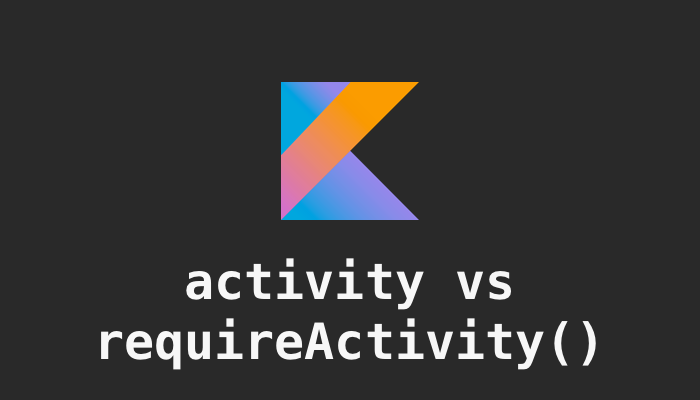Difference between activity and requireActivity() in Kotlin

activity property
In the Android framework, the Activity class represents an app's UI and provides an interface for the app to interact with the system. The activity property in a Fragment or Context object refers to the Activity that the Fragment or Context is currently associated with.
Here is an example of using the activity property in a Fragment to access the ActionBar of the associated Activity:
class MyFragment : Fragment() {
override fun onCreateView(inflater: LayoutInflater, container: ViewGroup?, savedInstanceState: Bundle?): View? {
// Inflate the layout for this fragment
val view = inflater.inflate(R.layout.fragment_my, container, false)
// Set the title of the ActionBar
activity?.actionBar?.title = "My Fragment"
return view
}
}
In this example, the activity property is used to access the ActionBar of the associated Activity. The ? operator is used to safely access the actionBar property in case the activity is null.
Note: ActionBar is deprecated in API level 28, you can use Toolbar instead.
requireActivity()
The requireActivity() function is a convenience function that retrieves the current Activity associated with a Fragment or Context, and throws an exception if the activity is null. This function is useful for ensuring that the Fragment or Context is associated with an Activity before trying to interact with it.
Here is an example of using the requireActivity() function in a Fragment to start another Activity:
class MyFragment : Fragment() {
override fun onViewCreated(view: View, savedInstanceState: Bundle?) {
super.onViewCreated(view, savedInstanceState)
// Find the button in the layout and set an OnClickListener
val button = view.findViewById<Button>(R.id.my_button)
button.setOnClickListener {
// Start another Activity
val intent = Intent(requireActivity(), AnotherActivity::class.java)
requireActivity().startActivity(intent)
}
}
}
In this example, the requireActivity() function is used to retrieve the current Activity associated with the Fragment and start another Activity by calling the startActivity(intent) method on it. It will throws IllegalStateException if there is no activity associated with this fragment. It's a safe way to use the activity instead of activity property and doing a null check.
Note: If you want to start an activity for result, you can use startActivityForResult(intent, requestCode) and onActivityResult(requestCode: Int, resultCode: Int, data: Intent?) methods instead.
When should use activity or requireActivity()
The main difference between the activity property and the requireActivity() function in Kotlin is how they handle the case when there is no Activity associated with a Fragment or Context.
- The
activityproperty is a regular property that returns the currentActivityassociated with aFragmentorContext, or null if there is no associatedActivity. When using theactivityproperty, you need to check if it's null before trying to interact with it. - The
requireActivity()function is a convenience function that retrieves the currentActivityassociated with aFragmentorContext, but it throws anIllegalStateExceptionif theactivityis null. This function is useful for ensuring that theFragmentorContextis associated with anActivitybefore trying to interact with it.
In general, it's recommended to use requireActivity() when you're sure that the fragment or context has an activity associated with it. This is because it will throw an exception if it is null, which will alert you to the problem, rather than silently returning null, making it harder to find the problem.
